Charles E W Bean, Diaries, AWM38 3DRL 606/273/1 - 1918 - 1937 - Part 22
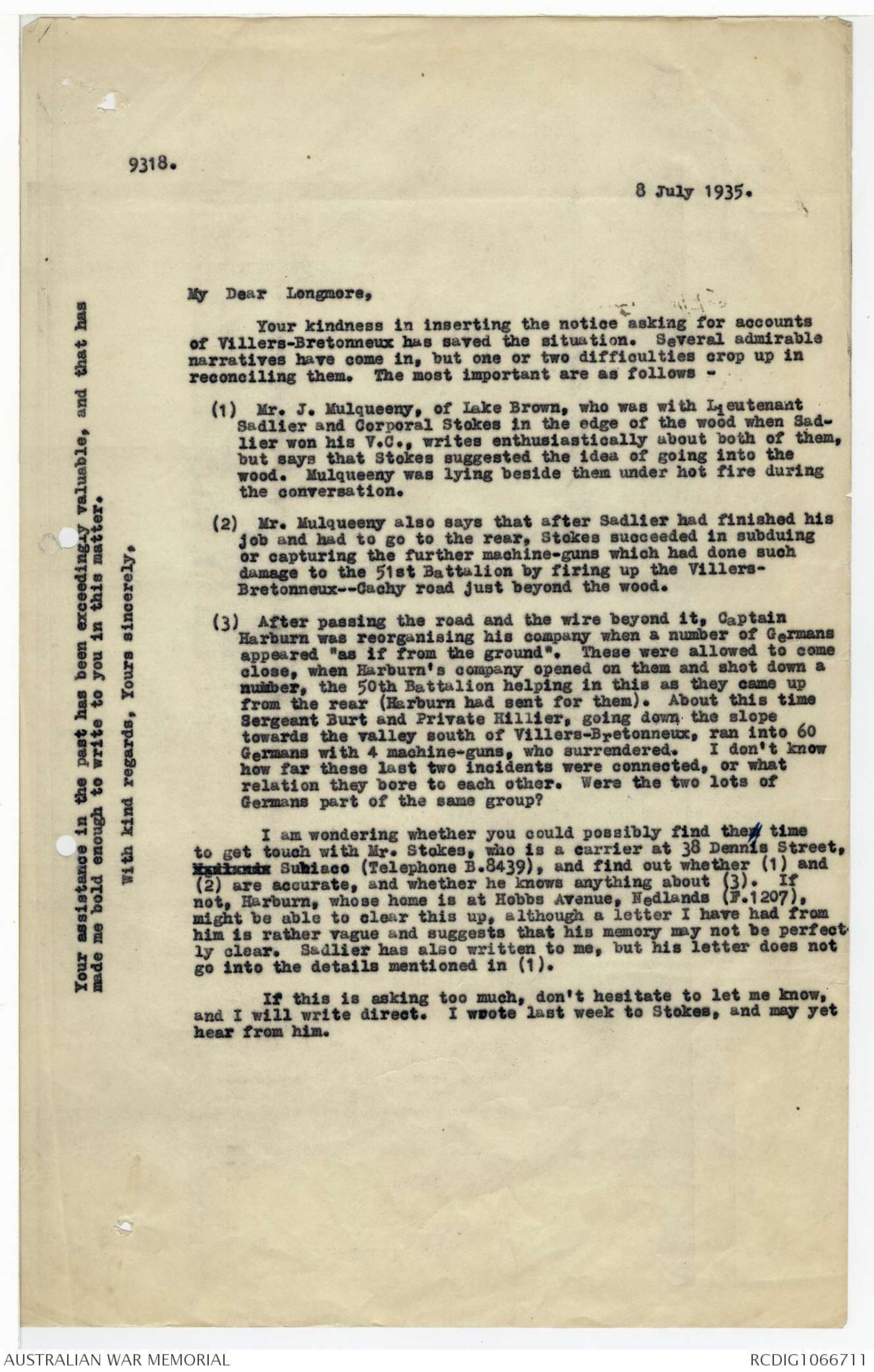

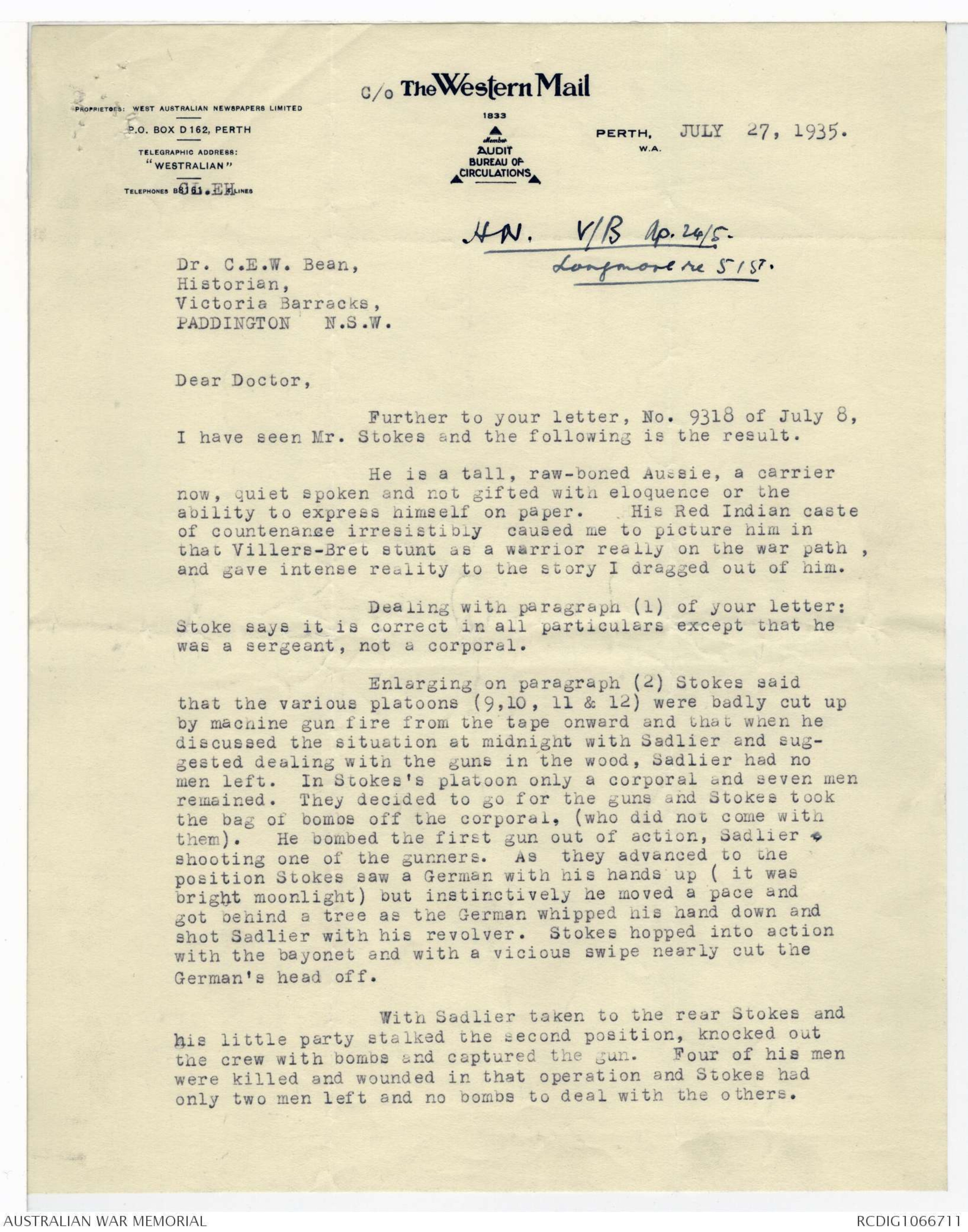

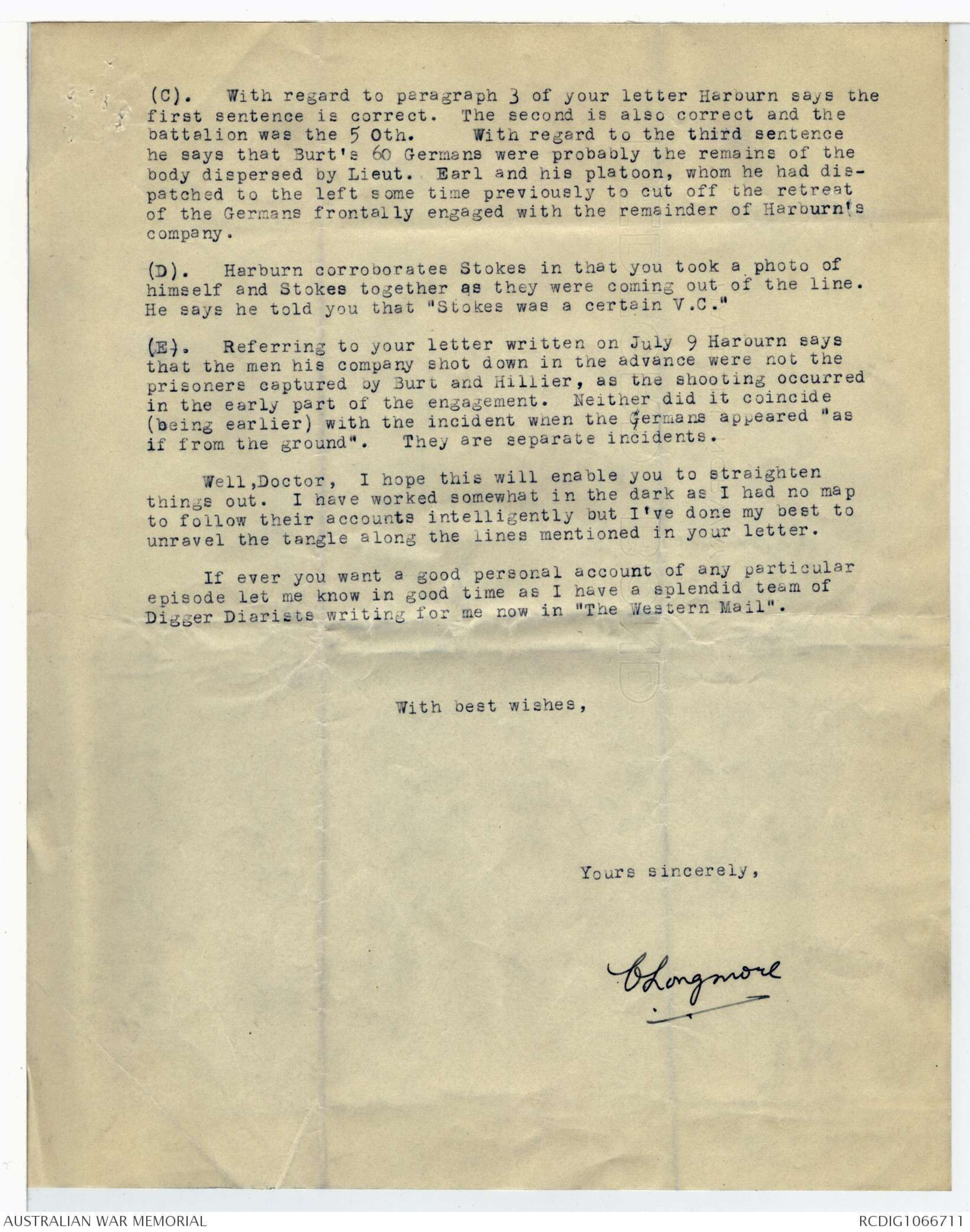
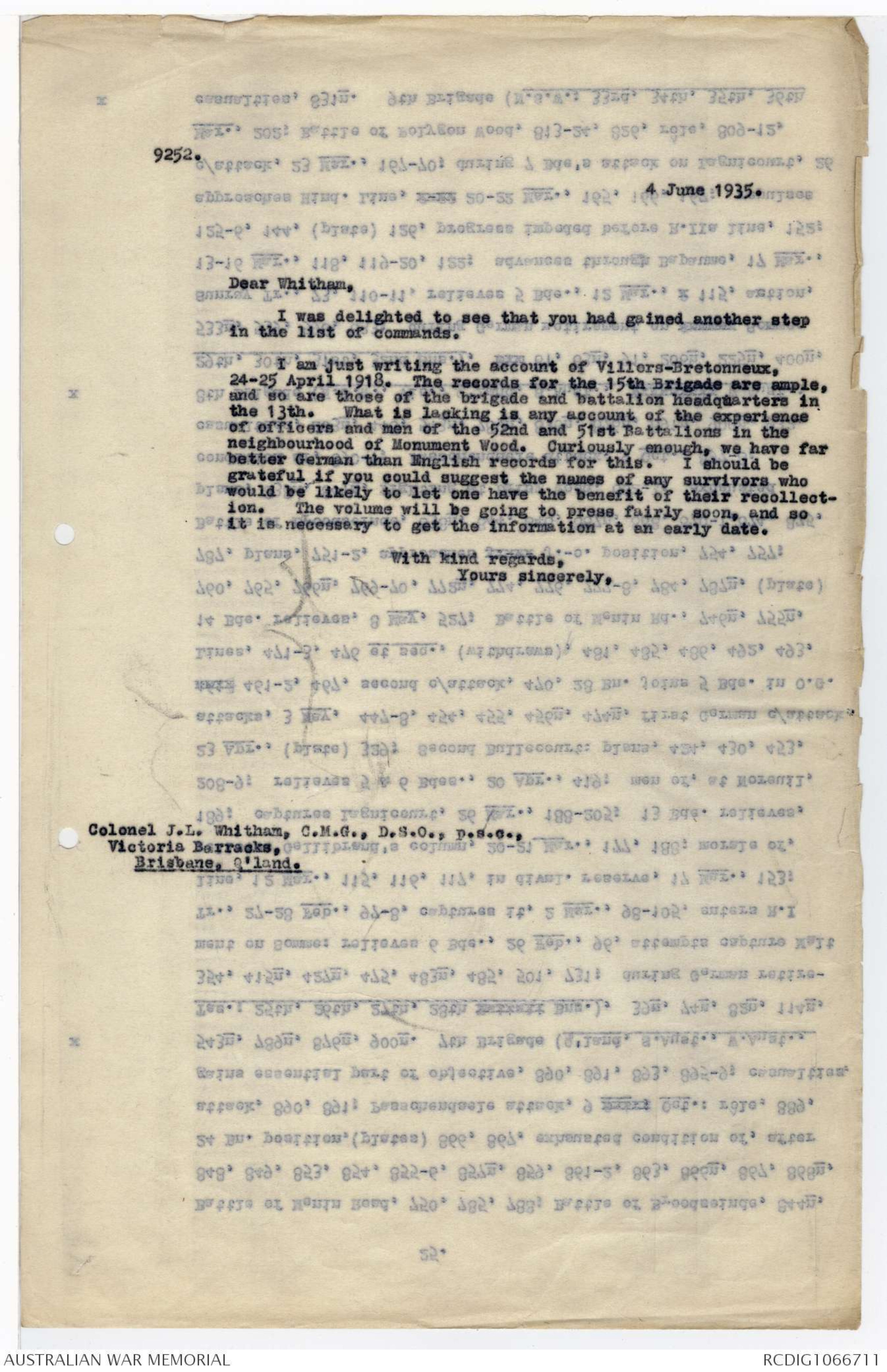
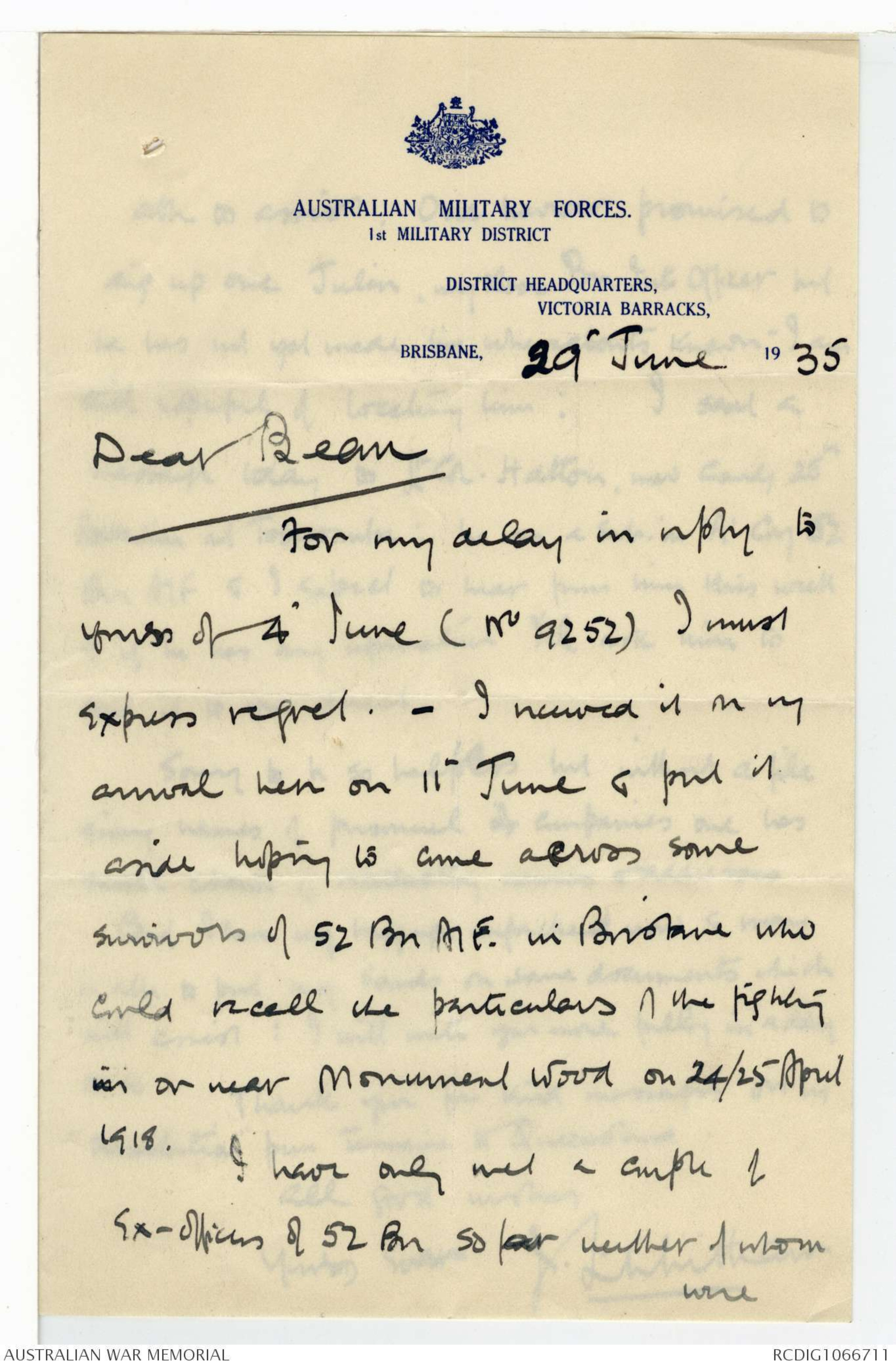
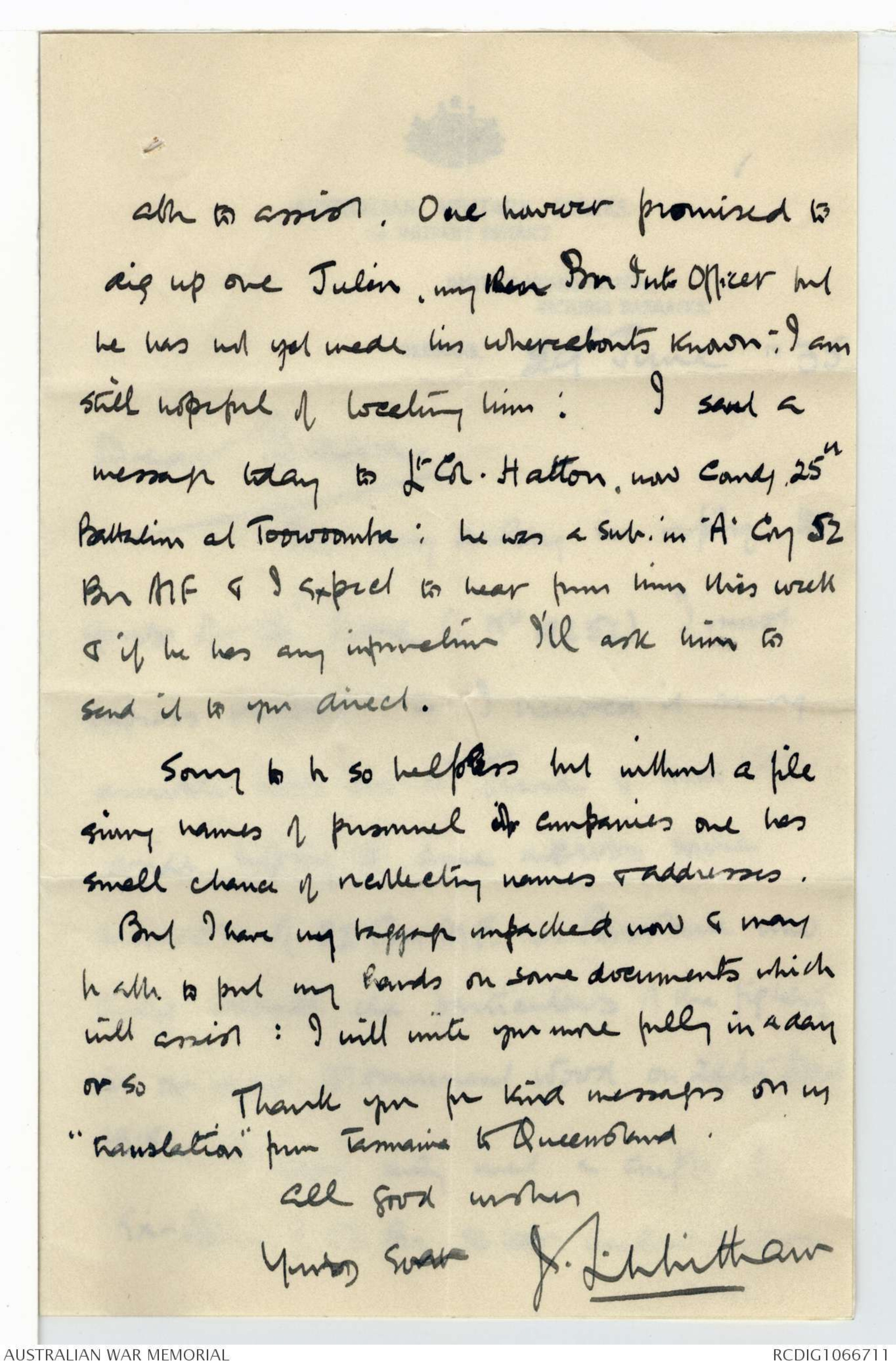
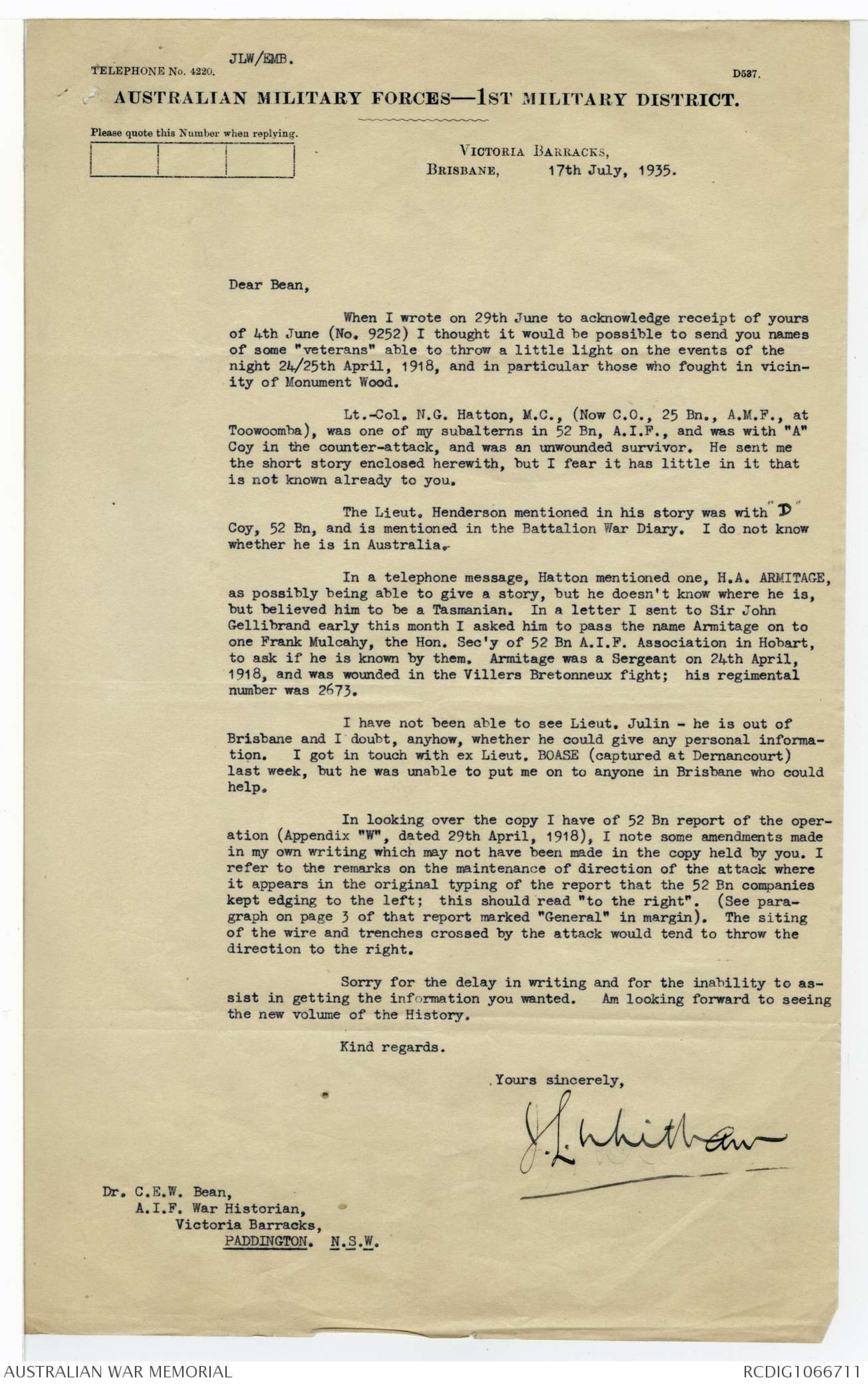
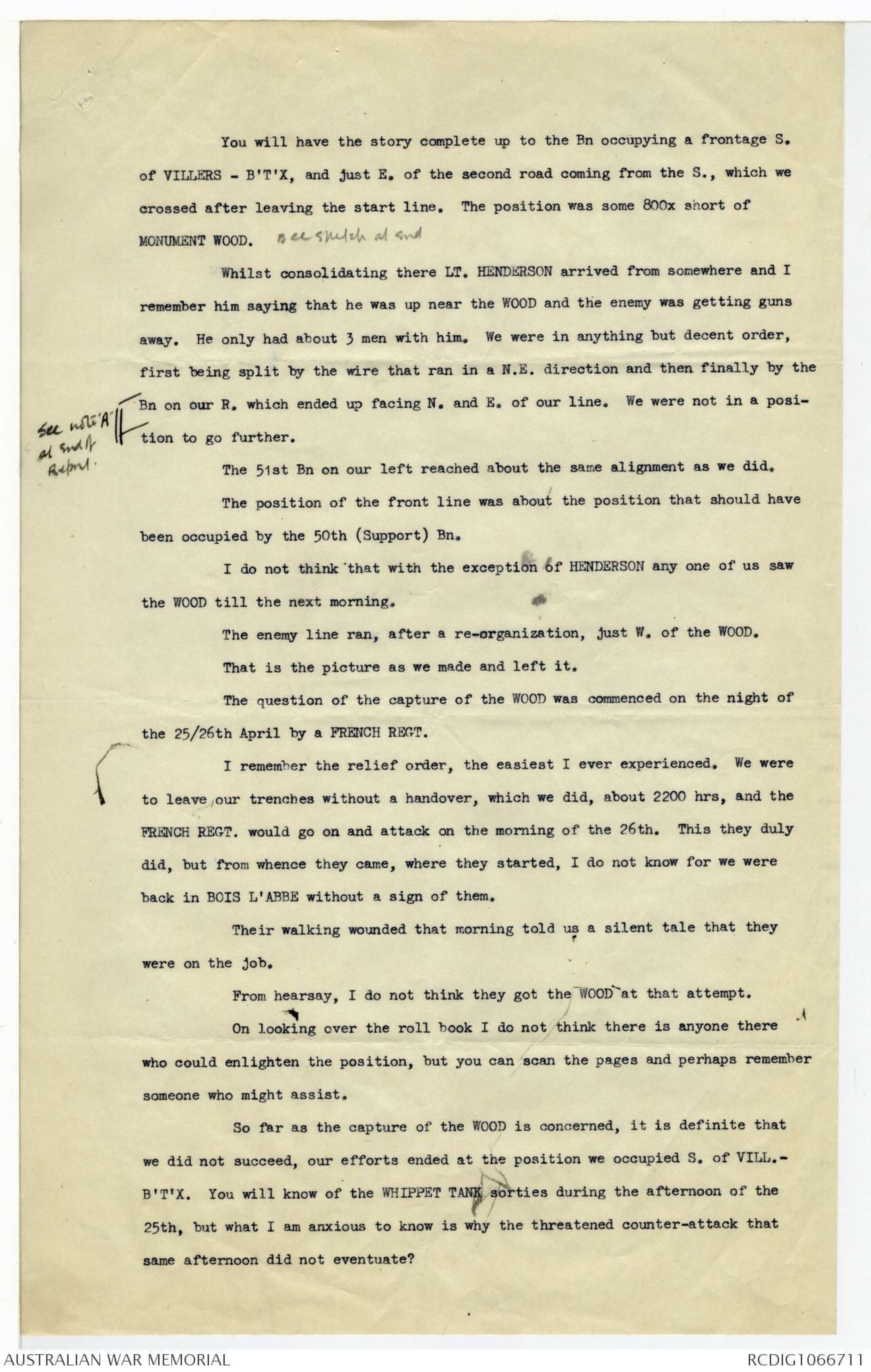
9318.
8 July 1935.
My Dear Longmore,
Your kindness in inserting the notice asking for accounts
of Villers-Bretonneux has saved the situation. Several admirable
narratives have come in, but one or two difficulties crop up in
reconciling them. The most important are as follows
(1) Mr. J. Mulqueeny, of Lake Brown, who was with Lieutenant
Sadlier and Corporal Stokes in the edge of the wood when Sadlier
won his V.C., writes enthusiastically about both of them,
but says that Stokes suggested the idea of going into the
wood. Mulqueeny was lying beside them under hot fire during
the conversation.
(2) Mr. Mulqueeny also says that after Sadlier had finished his
job and had to go to the rear, Stokes succeeded in subduing
or capturing the further machine-guns which had done such
damage to the 51st Battalion by firing up the Villers-
Bretonneux--Cachy road just beyond the wood.
(3) After passing the road and the wire beyond it, Captain
Harburn was reorganising his company when a number of Germans
appeared "as if from the ground". These were allowed to come
close, when Harburn's company opened on them and shot down a
number, the 50th Battalion helping in this as they came up
from the rear (Harburn had sent for them). About this time
Sergeant Burt and Private Hillier, going down the slope
towards the valley south of Villers-Bretonneux, ran into 60
Germans with 4 machine-guns, who surrendered. I don't know
how far these last two incidents were connected, or what
relation they bore to each other. Were the two lots of
Germans part of the same group?
I am wondering whether you could possibly find them time
to get touch with Mr. Stokes, who is a carrier at 38 Dennis Street,Nedlands Subiaco (Telephone B.8439), and find out whether (1) and
(2) are accurate, and whether he knows anything about (3). If
not, Harburn, whose home is at Hobbs Avenue, Nedlands (F.1207),
might be able to clear this up, although a letter I have had from
him is rather vague and suggests that his memory may not be perfectly
clear. Sadlier has also written to me, but his letter does not
go into the details mentioned in (1).
If this is asking too much, don't hesitate to let me know,
and I will write direct. I wrote last week to Stokes, and may yet
hear from him.
Your assistance in the past has been exceedingly valuable, and that has
made me bold enough to write to you in this matter.
With kind regards, Yours sincerely,
9321.
9 July 1935.
Dear Longmore.
Since writing to you yesterday, it has occurred to me
that I should mention that Captain Harburn writes that during the
advance his company met a large number of Germans with their
hands up, but that, having no means of dealing with prisoners, he
had to turn the Lewis gun on them and shoot them down. I think
that probably a certain number got back into Bois d'Aquenne. One
of my problems is this, that I don't know whether this may not
be the body of men captured by Sergeant Burt and Private Hillier
and also whether it may not be the incident referred to in
another account in which, when Harburn was reorganising, a
company of Germans appeared "asxif from the ground" and was
approaching his flank when he turned fire on them, a company of
the 50th also coming up at the same moment. It is important
know whether these are separate incidents, or all versions of
the same incident.
I should like to get over there and disentangle it
myself, but there appears to be no chance of this, and that is
why I have written to you.
With apologies for troubling you,
Yours sincerely,
Captain C. Longmore
"The West Australian" office,
P.O. Box D.162.
Perth, W.Aust.
PROPRIETORS: WEST AUSTRALIAN NEWSPAPERS LIMITED
P.O. BOX D 162, PERTH
TELEGRAPHIC ADDRESS:
"WESTRALIAN"
TELEPHONE B8161.- 4 LINES
GL.EH
C/o The Western Mail
1833
Member
AUDIT
BUREAU OF
CIRCULATIONS
PERTH,
W.A.
JULY 27, 1935
[* HN. V/B Ap 24/5.
Longmore re 51ST.*]
Dr. C. E. W. Bean,
Historian,
Victoria Barracks,
PADDINGTON N.S.W.
Dear Doctor,
Further to your letter, No. 9318 of July 8,
I have seen Mr. Stokes and the following is the result.
He is a tall, raw-boned Aussie, a carrier
now, quiet spoken and not gifted with eloquence or the
ability to express himself on paper. His Red Indian caste
of countenance irresistibly, caused me to picture him in
that Villers-Bret stunt as a warrior really on the war path,
and gave intense reality to the story I dragged out of him.
Dealing with paragraph (1) of your letter:
Stoke says it is correct in all particulars except that he
was a sergeant, not a corporal.
Enlarging on paragraph (2) Stokes said
that the various platoons (9,10, 11 & 12) were badly cut up
by machine gun fire from the tape onward and that when he
discussed the situation at midnight with Sadlier and suggested
dealing with the guns in the wood, Sadlier had no
men left. In Stokes's platoon only a corporal and seven men
remained. They decided to go for the guns and Stokes took
the bag of bombs off the corporal, (who did not come with
them). He bombed the first gun out of action, Sadlier a
shooting one of the gunners. As they advanced to the
position Stokes saw a German with his hands up (it was
bright moonlight) but instinctively he moved a pace and
got behind a tree as the German whipped his hand down and
shot Sadlier with his revolver. Stokes hopped into action
with the bayonet and with a vicious swipe nearly cut the
German's head off.
With Sadlier taken to the rear Stokes and
his little party stalked the second position, knocked out
the crew with bombs and captured the gun. Four of his men
were killed and wounded in that operation and Stokes had
only two men left and no bombs to deal with the others.
2.
Then Stokes met Corporal Bob West, who had two rifle grenades,
and with these Stokes attacked the third gun. Both grenades
missed and West then went back and collected some German stick
bombs. Stokes put two of these right into the position, knocked
the crew out, and took the gun.
The fourth gun was manned by only one German and Stokes crept
into a favourable position, shot the gunner and captured the gun.
There was still a fifth gun in the wood giving a lot of trouble.
Stokes met Corporal Meldrum, of "B" Company, with a Lewis gun, and
pointed the enemy piece out to him. They had just crept into a
favourable position to deliver a burst and were getting ready when
the German fired first. One bullet knocked Stokes's steel helmet
off and another got Meldrum in the leg. While Stokes was attending
to Meldrum the German moved his gun back. At any rate the position
was clear when Stokes next looked for him.
All this happened between, about midnight, when Sadlier and
Stokes first discussed the guns, and 4 a.m., when the fifth gun
was disposed of in the manner indicated above.
With regard to paragraph (3); Stokes says the first sentence
is correct. The second sentence is also correct, except that he
is sure it was a company of the 49th., not the 50th. He doesn't
know anything about Burt and Hillier in the third sentence, and so
cannot answer your question at the end of the paragraph. Stokes
says that you (Dr. Bean) or someone sent by you took his photograph
as the remnants of the battalion were coming out of the line
after this engagement.
On Friday last, Captain Harburn, who is a country traveller
and only in town during the week-ends, called to see me by appointment
and I went over your letters and Stoke's evidence. The following
is the result:
(A). Re paragraph 1 of your letter. Stokes was a sergeant.
Harburn does not know personally, but in the battalion just afterwards
the story was current in accordance with the details as given
by Mulqueeny.
(B). Regarding paragraph 2 of your letter and Stoke's account,
Harburn says they are correct, so far as he knew or gathered at the
time or immediately afterwards. He thinks Stokes is astray about
times, and believes that these events happened between 10 p.m.
and midnight. The show, was over at midnight with the excepption
perhaps of the fifth gun.
(C). With regard to paragraph 3 of your letter Harburn says the
first sentence is correct. The second is also correct and the
battalion was the 50th. With regard to the third sentence
he says that Burt's 60 Germans were probably the remains of the
body dispersed by Lieut. Earl and his platoon, whom he had dispatched
to the left some time previously to cut off the retreat
of the Germans frontally engaged with the remainder of Harburn's
company.
(D). Harburn corroborates Stokes in that you took a photo of
himself and Stokes together as they were coming out of the line.
He says he told you that "Stokes was a certain V.C."
(E). Referring to your letter written on July 9 Harburn says
that the men his company shot down in the advance were not the
prisoners captured by Burt and Hillier, as the shooting occurred
in the early part of the engagement. Neither did it coincide
(being earlier) with the incident when the Germans appeared "as
if from the ground". They are separate incidents.
Well, Doctor, I hope this will enable you to straighten
things out. I have worked somewhat in the dark as I had no map
to follow their accounts intelligently but I've done my best to
unravel the tangle along the lines mentioned in your letter.
If ever you want a good personal account of any particular
episode let me know in good time as I have a splendid team of
Digger Diarists writing for me now in "The Western Mail".
With best wishes,
Yours sincerely,
C Longmore
9252.
4 June 1935.
Dear Whitham,
I was delighted to see that you had gained another step
in the list of commands.
I am just writing the account of Villers-Bretonneux,
24-25 April 1918. The records for the 15th Brigade are ample
and so are those of the brigade and battalion headquarters in
the 13th. What is lacking is any account of the experience
of officers and men of the 52nd and 51st Battalions in the
neighbourhood of Monument Wood. Curiously enough, we have far
better German than English records for this. I should be
grateful if you could suggest the names of any survivors, who
would be likely to let one have the benefit of their recollection.
The volume will be going to press fairly soon, and so
it is necessary to get the information at an early date.
With kind regards,
Yours sincerely.
Colonel J. L. Whitham, C.M.G., D.S.O., p.s.c.,
Victoria Barracks,
Brisbane. Q'land.
AUSTRALIAN MILITARY FORCES.
1st MILITARY DISTRICT
DISTRICT HEADQUARTERS,
VICTORIA BARRACKS,
BRISBANE,
29 June 1935
Dear Bean
For my delay in reply to
yours of June (No9252) I must
express regret. – I received it on my
annual leave on 11 June & put it
aside hoping to come across some
survivors of 52 Bn AIF. in Brisbane who
could recall the particulars of the fighting
in or near Monument Wood on 24/25 April
1918.
I have only met a couple of
ex-officers of 52 Bn so far neither of whom were
able to assist. One however promised to
dig up one Julin, my then Bn Int Officer but
he has not yet made his whereabouts known. I am
still hopeful of locating him. I sent a
message today to Lt Col Hatton, now Comdr 25th
Battalion at Toowoomba: he was a sub. in 'A' Coy 52
Bn AIF & I expect to hear from him this week
& if he has any information I'll ask him to
send it to you direct.
Sorry to be so helpless but without a file
giving names of personnel of Companies one has
small chance of collecting names & addresses.
But I have my baggage unpacked now & may
be able to put my hands on some documents which
will assist : I will write you more fully in a day
or so
Thank you for kind messages on my
"translation" from Tasmania to Queensland.
All good wishes
Yours Sin[?]
J. L. Whitham
JLW/EMB.
TELEPHONE NO. 4220.
D537.
AUSTRALIAN MILITARY FORCES—1ST MILITARY DISTRICT.
Please quote this Number when replying.
VICTORIA BARRACKS,
BRISBANE,
17th July, 1935.
Dear Bean,
When I wrote on 29th June to acknowledge receipt of yours
of 4th June (No. 9252) I thought it would be possible to send you names
of some "veterans" able to throw a little light on the events of the
night 24/25th April, 1918, and in particular those who fought in vicinity
of Monument Wood.
Lt.-Col. N.G. Hatton, M.C., (Now C.O., 25 Bn., A.M.F., at
Toowoomba), was one of my subalterns in 52 Bn, A.I.F., and was with "A"
Coy in the counter-attack, and was an unwounded survivor. He sent me
the short story enclosed herewith, but I fear it has little in it that
is not known already to you.
The Lieut. Henderson mentioned in his story was with "D"
Coy, 52 Bn, and is mentioned in the Battalion War Diary. I do not know
whether he is in Australia.
In a telephone message, Hatton mentioned one, H.A. ARMITAGE,
as possibly being able to give a story, but he doesn't know where he is,
but believed him to be a Tasmanian. In a letter I sent to Sir John
Gellibrand early this month I asked him to pass the name Armitage on to
one Frank Mulcahy, the Hon. Sec'y of 52 Bn A.I.F. Association in Hobart,
to ask if he is known by them. Armitage was a Sergeant on 24th April,
1918, and was wounded in the Villers Bretonneux fight; his regimental
number was 2673.
I have not been able to see Lieut. Julin - he is out of
Brisbane and I doubt, anyhow, whether he could give any personal information.
I got in touch with ex Lieut, BOASE (captured at Dernancourt)
last week, but he was unable to put me on to anyone in Brisbane who could
help.
In looking over the copy I have of 52 Bn report of the operation
(Appendix "W", dated 29th April, 1918), I note some amendments made
in my own writing which may not have been made in the copy held by you. I
refer to the remarks on the maintenance of direction of the attack where
it appears in the original typing of the report that the 52 Bn companies
kept edging to the left; this should read "to the right". (See paragraph
on page 3 of that report marked "General" in margin). The siting
of the wire and trenches crossed by the attack would tend to throw the
direction to the right.
Sorry for the delay in writing and for the inability to assist
in getting the information you wanted. Am looking forward to seeing
the new volume of the History.
Kind regards.
Yours sincerely,
J. L. Whitham
Dr. C.E.W. Bean,
A.I.F. War Historian,
Victoria Barracks,
PADDINGTON. N.S.W.
You will have the story complete up to the Bn occupying a frontage S.
of VILLERS - B'T'X, and just E. of the second road coming from the S., which we
crossed after leaving the start line. The position was some 800x short of
MONUMENT WOOD.
[*see sketch at end*]
Whilst consolidating there LT. HENDERSON arrived from somewhere and I
remember him saying that he was up near the WOOD and the enemy was getting guns
away. He only had about 3 men with him. We were in anything but decent order,
first being split by the wire that ran in a N.E. direction and then finally by the
Bn on our R. which ended up facing N. and E. of our line. We were not in a position
[* see note 'A" at end of Report. *]
to go further.
The 51st Bn on our left reached about the same alignment as we did.
The position of the front line was about the position that should have
been occupied by the 50th (Support) Bn.
I do not think that with the exception of HENDERSON any one of us saw
the WOOD till the next morning.
The enemy line ran, after a re-organization, just W. of the WOOD.
That is the picture as we made and left it.
The question of the capture of the WOOD was commenced on the night of
the 25/26th April by a FRENCH REGT.
I remember the relief order, the easiest I ever experienced. We were
to leave our trenches without a handover, which we did, about 2200 hrs, and the
FRENCH REGT. would go on and attack on the morning of the 26th. This they duly
did, but from whence they came, where they started, I do not know for we were
back in BOIS L'ABBE without a sign of them.
Their walking wounded that morning told us a silent tale that they
were on the job.
From hearsay, I do not think they got the WOOD at that attempt.
On looking over the roll book I do not think there is anyone there
who could enlighten the position, but you can scan the pages and perhaps remember
someone who might assist.
So far as the capture of the WOOD is concerned, it is definite that
we did not succeed, our efforts ended at the position we occupied S. of VILL.-
B'T'X. You will know of the WHIPPET TANK sorties during the afternoon of the
25th, but what I am anxious to know is why the threatened counter-attack that
same afternoon did not eventuate?
 Sam scott
Sam scottThis transcription item is now locked to you for editing. To release the lock either Save your changes or Cancel.
This lock will be automatically released after 60 minutes of inactivity.